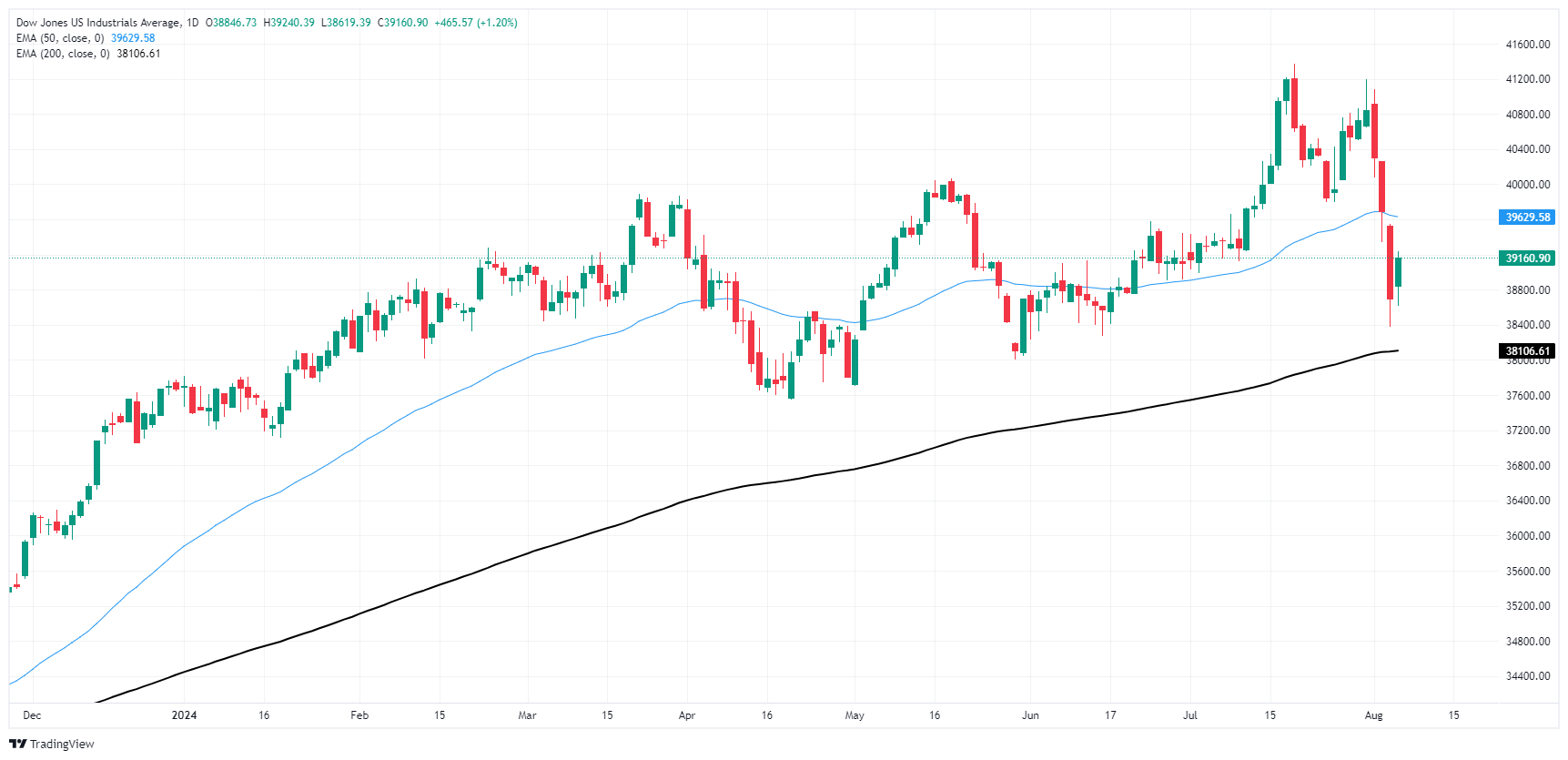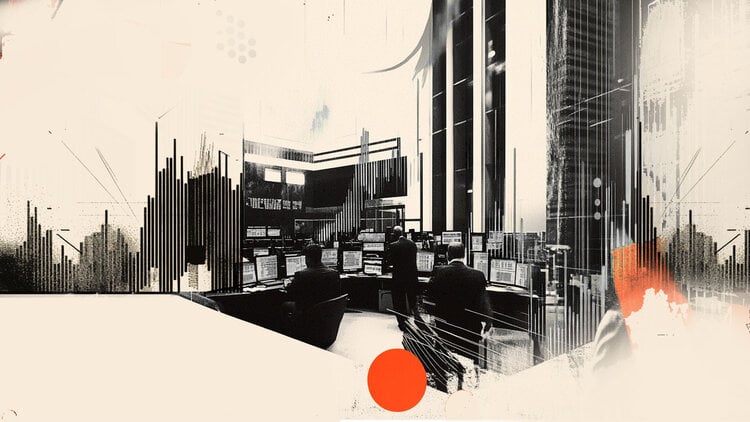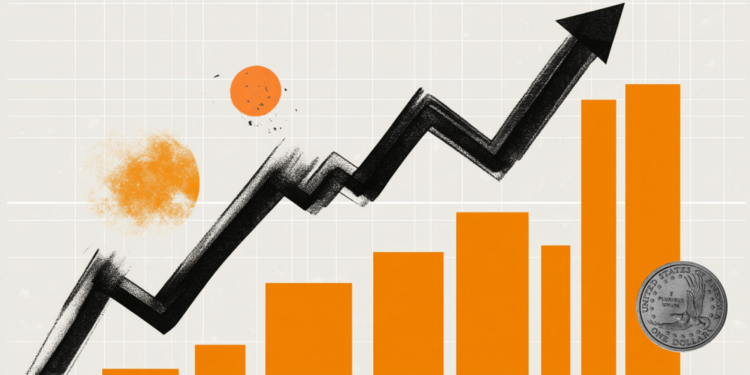- The Dow Jones is looking for a support point after a general market decline.
- Stocks are broadly higher on Tuesday, but still at the bottom of a long hole.
- Investors continue to crave Fed rate cuts, but an “emergency cut” appears out of the question.
The Dow Jones Industrial Average (DJIA) regained ground on Tuesday, rallying close to 500 points after the index spent several days facing sharp declines. Investors are regaining their footing after a broad-based drop in key U.S. economic data sent risk sentiment crashing to the ground and rekindled broader market fears of a U.S. recession.
Markets have regained their composure after sending the Dow Jones down 7% from last week’s peak near 41,200.00, but Dow Jones bidders will have their work cut out for them to bring price action back to the upside. The flow of US economic data has calmed down for the moment, but hopes for rate cuts by the Federal Reserve (Fed) continue to simmer in the background.
Rate markets have fully priced in a September rate cut, and according to the CME’s FedWatch tool, investors see two-to-one odds of a double 50-basis-point cut when the Federal Open Market Committee (FOMC) delivers its rate decision on Sept. 18. At the current cut, rate markets see zero chance of the Fed holding rates steady in 2024, with a total of four quarter-point cuts expected by year-end.
Dow Jones News
The majority of the Dow Jones index is in the green on Tuesday, with less than a third of its constituent stocks remaining stubbornly in the red. The losses are being led by Intel Corp. (INTC), which recently missed revenue estimates and lowered its forward guidance on third-quarter earnings. Citing narrow margins and struggling profitability, Intel’s revenue fell 1% to a total of $12.8 billion in the second quarter, missing analysts’ forecasts by $150 million.
After revealing the revenue decline and missed guidance, Intel announced it would suspend its December dividend payment and lay off about 10% of its workforce, or about 15,000 people. This comes after Intel received more than $8.5 billion in government grants earlier in the year, with the potential for another $11 billion in additional grants in the future.
Dow Jones Technical Outlook
The Dow Jones managed to avoid further declines as overall market sentiment regains its footing, keeping the index above the 200-day exponential moving average (EMA) at 37,934.50. However, the DJIA remains far from the all-time highs set in July at 41,371.38 and buyers have a long way to go back to record highs.
The 50-day EMA awaits above the intraday price action at 39,632.50, while bidders will look to sustain prices above the 38,500.00 level after Monday’s technical bounce from that price level.
Dow Jones daily chart
The Dow Jones FAQs
The Dow Jones Industrial Average, one of the world’s oldest stock market indexes, is made up of the 30 most actively traded stocks in the United States. The index is weighted by price rather than capitalization. It is calculated by adding up the prices of the component securities and dividing by a factor, currently 0.152. The index was founded by Charles Dow, also founder of the Wall Street Journal. In recent years it has been criticized for not being sufficiently representative, as it only tracks 30 companies, unlike broader indexes such as the S&P 500.
There are many factors that drive the Dow Jones Industrial Average (DJIA). The main one is the aggregate performance of the companies that comprise it, as revealed in quarterly corporate earnings reports. US and global macroeconomic data also contribute, as they influence investor confidence. The level of interest rates, set by the Federal Reserve (Fed), also influences the DJIA, as it affects the cost of credit, on which many companies rely heavily. Therefore, inflation can be a determining factor, as well as other parameters that influence the decisions of the Federal Reserve.
Dow Theory is a method for identifying the major trend of the stock market developed by Charles Dow. A key step is to compare the direction of the Dow Jones Industrial Average (DJIA) and the Dow Jones Transportation Average (DJTA) and only follow trends where both move in the same direction. Volume is a confirmation criterion. The theory uses elements of peak-trough analysis. Dow Theory posits three phases of a trend: accumulation, when smart money starts buying or selling; public participation, when the general public joins the trend; and distribution, when smart money leaves the trend.
There are several ways to trade the DJIA. One is to use ETFs that allow investors to trade the DJIA as a single security, rather than having to buy shares of all 30 companies that comprise it. A prominent example is the SPDR Dow Jones Industrial Average ETF (DIA). Futures contracts on the DJIA allow traders to speculate on the future value of the index, and options provide the right, but not the obligation, to buy or sell the index at a predetermined price in the future. Mutual funds allow investors to purchase a portion of a diversified portfolio of DJIA securities, providing exposure to the overall index.
Source: Fx Street
I am Joshua Winder, a senior-level journalist and editor at World Stock Market. I specialize in covering news related to the stock market and economic trends. With more than 8 years of experience in this field, I have become an expert in financial reporting.







